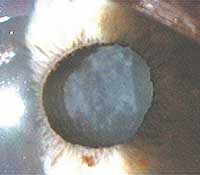Study: ICL implantations show good results
Snapshot of procedure throughout South America finds ICL results have been “positive.”
BELO HORIZONTE, Brazil — The ICL from STAAR Surgical (Nidau, Switzerland) has had “positive” results in the hands of surgeons throughout Latin America, according to an informal survey conducted by Ricardo Guimaraes, MD, in practice here.
Dr. Guimaraes, who practices at the Hospital de Olhos de Minas Gerais, presented a snapshot of ICL implantation in South America.
“Latin America has a long tradition of refractive surgery with some distinguished names,” Dr. Guimaraes said. “I’m proud to be a part of this group.”
About 10,000 eyes worldwide have received ICL implants. Most have been done in Europe, where 7,000 eyes have undergone implantation. Latin America has seen 1,500 procedures. Another 900 have been performed in South Africa, 500 in the United States, 200 in the Cayman Islands and 100 in Asia. In Latin America, Roberto Zaldivar, MD, of Argentina, began implanting the lenses in 1994, Dr. Guimaraes said. Now, 23 surgeons implant the lenses in their practices in Argentina, Brazil, Chile, Mexico, Colombia and Venezuela.
Dr. Guimaraes sent a questionnaire to the top 10 surgeons implanting the ICL in Latin America to learn about their techniques and results.
Survey results
Surgeons have been implanting the ICL for an average of 2 years, with a range of 1 to 5. Surgeons have implanted an average of 65 lenses, with a range of 1 to 500 lenses. Most surgeons have implanted between 20 and 30 lenses, and only a few have performed more than 100 cases, Dr. Guimaraes said.
Surgeons surveyed implanted 82% of lenses to correct myopia, 15% for hyperopia and 3% for keratoconus and other indications.
Most of the surgeons surveyed used the ICL for myopia greater than 10 D, with a range of 8 D to 14 D, and for hyperopia greater than 5 D, with a range of 4 D to 7 D. They also used the ICL in patients with refractive errors and corneas less than 450 µm.
All the responding surgeons create two iridotomies preoperatively, although their locations varied widely. Most surgeons used laser in situ keratomileusis to correct residual spherical and cylindrical error, although some surgeons used incisional refractive procedures or IOL exchange.
Seventy percent of surgeons surveyed also used anterior chamber lenses or iris fixated IOLs. The choice of using these methods or the ICL is determined by cost and pupil size.
| Pros and cons of PC phakic IOLs | |
| Pros: no irreversible vision threatening complications, good predictability and good vision quality. | |
 |
 |
Cons: cost of the lens and risk of cataract. |
|
 |
 |
Complications reviewed
Some type of complication occurred to 75% of surgeons who responded to the survey. The remainder reported no complications. And 37.5% of surgeons reported cataracts occurring among their patients, mostly as a result of surgical trauma or a lack of space between the ICL and crystalline lens.
Half of the surgeons reported intraocular pressure elevation, and half reported the IOL tearing upon implantation. Surgeons aborted 0.5% of cases because of problems with the lens and injector. STAAR said it has designed a new injector in response to physicians’ suggestions.
Surgeons reported that they like the ICL’s lack of irreversible vision-threatening complications, its good predictability and high quality of vision, but they dislike the risk of cataract and the high lens cost, Dr. Guimaraes said.
He added that the best ways to avoid complications were patient selection, careful measurements of the white-to-white distance, slow lens implantation and generous use of viscoelastics. Surgeons used all types of viscoelastics.
“The ICL was considered a positive technology for the correction of high ametropia, but it is still restricted to a few surgeons,” Dr. Guimaraes said. “It presents a low rate of complications. Cataracts and cost are the main limitations for the procedure.”
For Your Information:
- Ricardo Guimaraes, MD, can be reached at the Hospital de Olhos de Minas Gerais, Rua Paisagem 222, Villa de Serra, Belo Horizonte/ MG, 30161-970 Brazil; +(55) 31-289-2000; fax: +(55) 31-289-2150. Dr. Guimaraes has no direct financial interest in any of the products mentioned in this article, nor is he a paid consultant for any companies mentioned.
- STAAR Surgical AG can be reached at Hauptstrasse 104, CH 2560, Nidau, Switzerland; +(41) 32-332-8888; fax: +(41) 32-332-8899.
